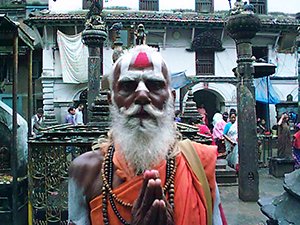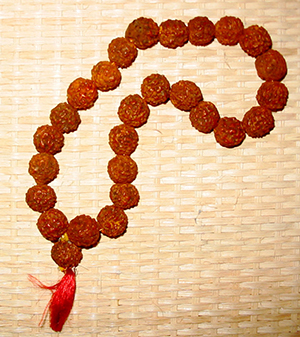Hindu Prayer Beads
Japa Mala

Image "Sadhu" courtesy of Suraj Shakya
Hinduism is the first religion known to have used prayer beads, which are called Japa Mala or mala. In Sanskrit, mala means "garland", while Japa means to recite or chant a mantra or name of a deity. The mala are used to count the recitations.
Malas usually have 108 beads and an extra, larger bead called a meru. However the number can vary. Malas are made from a wide variety of materials, and in a wide variety of styles. Their use is particularly associated with sadhus (holy men) and sadvis (holy women), who are renunciates and usually yogis.
Materials used to make mala beads

Image courtesy of:Nesusvet (Own work) [Public domain], via Wikimedia Commons
Malas are made from a variety of materials; Hindu mala beads are usually made from:
- Sandalwood, which is the most common and least expensive
- Seeds of the rudraksha tree, sacred to devotees of Siva.
- Wood of the Tulsi plant, sacred to devotees of Vishnu.
- Bone.
- Precious or semi-precious stones.
Usage
Malas are most ofter used to count repetitions of a mantra, but they are also used to aid in meditation, and for other forms of sadhana (spiritual exercise). A mantra is a sound, syllable, word or group of these, whose repetition is believed to create transformation.
When used for mantras, the mala is held in the right hand, and one bead is counted for each repetition of the mantra. When a mala with 109 beads are used, the largest, the meru (also called a sumeru, bindu, stupa, or guru bead) marks the beginning and end: the bead next to the meru is the first, and the last one before reaching the meru is the last. When performing more than 108 repetitions, the meru is not crossed, but rather the user changes directions, and counts back the other way.
Mantras can be found at freemeditationinfo.com.